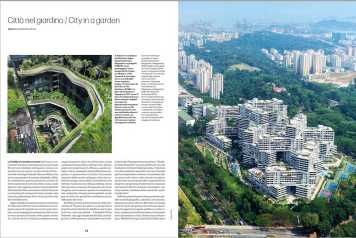Città nel giardino / City in a garden
...Says Srilalitha Gopalakrishnan, a landscape architect, researcher at the Singapore-ETH Centre Future Cities Laboratory... (Testo/Text Valentina Croci)

p 19
Says Srilalitha Gopalakrishnan, a landscape architect, researcher at the Singapore-ETH Centre Future Cities Laboratory, and Ph. D. candidate at the Singapore University of Technology and Design: “Density and sustainability must not be seen as contradictory, but as mutually dependent and synergistic. We are exploring the benefits of innovative building types that include high-rise greenery in the form of public and common spaces, extensive terraces, sky bridges, vertical parks and roof gardens. Applied to residential, civic and commercial programmes, these elements produce dense, green cities. This optimises land use, raises its value and diminishes the need to build. In Singapore, buildings like the School of the Arts (2010) designed by WOHA with landscaping by Cicada Private, and the hotel ParkRoyal on Pickering (2013) by WOHA with landscaping by Tierra Design opened a new approach. Connecting buildings to green corridors, parks and nature reserves forms a
matrix that can become part of larger ecosystems,” continues Gopalakrishnan. “Dense and green buildings provide important regulating services such as mitigating urban heat-island effects. We have case studies where high-rise vegetation led to a decrease of surface temperatures of up to 23.5 degrees Celsius. Our research found that construction and maintenance costs of dense and green buildings were variable but generally affordable. They add between 1.5 and 4.5 per cent to the overall cost, with evident advantages
for the environment and our psychological well-being. “The road to implementing these undeniable benefits for city and citizens is not without difficulties. For one, using the right construction methods (modular, customised, in situ) requires a thorough consideration of building processes and elements including spatial planning, technical compliances related to safety, facade systems, structural frameworks as well as mechanical and electrical systems. Another challenge is convincing stakeholders to maintain the vertical vegetation,” concludes Gopalakrishnan.Indubitably, the Singaporean model of building and planning sees the city as an ecological system, allowing it to be read as a living organism directly related to our health and well-being. This type of design outlook could lead to the creation of more liveable, sustainable and resilient urban surroundings.
1051_14-19_CONTRACT_Biofilia